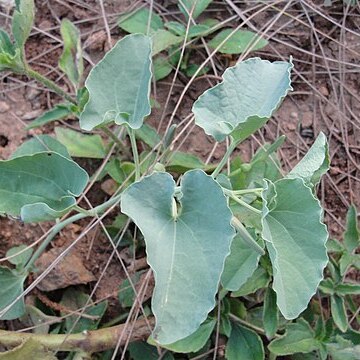A perennial or rarely annual (? flowering in first year) mostly prostrate but occasionally climbing or suberect ± glaucous unpleasantly smelling herb 10–40 cm. long; stems woody at base, whitish, flexuous, striate, arising from underground rhizome.. Leaves ovate to ± round, 1.3–6 cm. long and wide, obtuse, cordate at the base, glabrous, glaucous at least beneath; petiole striate, 0.5–3 cm. long.. Flowers solitary, axillary, occurring at most axils; bracts conspicuous, ± round, 0.6–1.7 cm. in diameter, glabrous; pedicels 5–10 mm. long, lengthening to ± 2 cm. in fruit.. Perianth mostly yellow-brown with purple or maroon lip, or green at base, but other notes mention creamy with chocolate centre or the reverse, deep brown with white throat, mostly 2.5–4 cm. long, the tubular part densely hairy within; inflated part of tube subglobose or ovoid, 7–8 mm. long, 4–8 mm. wide, tubular part 1–1.5 cm. long; limb oblanceolate-oblong to linear-oblong, 2–2.2 cm. long, 3–7 mm. wide, obtuse, with short characteristic hairs on the upper half inside.. Stamens 6, the gynostegium lobes ± ovate, ± 1 mm. long, acute; placentas parietal in the upper portion but intruded and meeting at centre below, axile.. Capsule pale, subglobose to ovoid-ellipsoid, (1–)2–3 cm. long, ± 1.5 cm. wide, glabrous and slightly glaucous, 12-ribbed.. Seeds numerous, dark, flat, triangular, 5–7 mm. long, 4.5 mm. wide, pointed at one end, ± emarginate at the other, rugose save for median area on one face.
More
A herb that lies along the ground. It keeps growing from year to year. It has an unpleasant smell. The leaves are 1.5-3 cm long and oval but spear shaped at the base. The flowers have large bracts.
A small glabrous shrub, stems flexuous from a woody base
Flowers yellow-brown with a purple lip.
Banks of rivers in India. Acacia-Commiphora bushland, Acacia desert grassland by dry sand-rivers with scattered Acacia tortilis, scrub, on sandy or lava soils at elevations of 220-900 metres in east Africa.
Can be grown by cuttings or seedlings. Seeds needs soaking.

